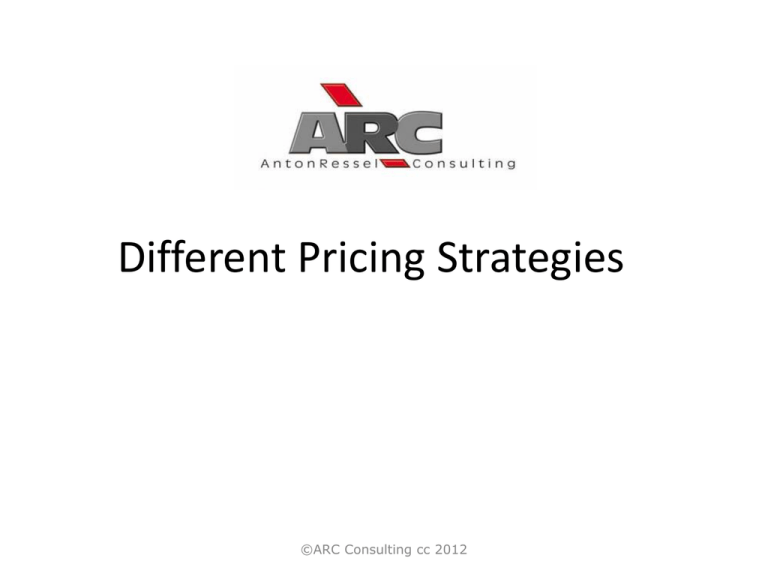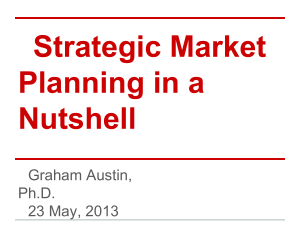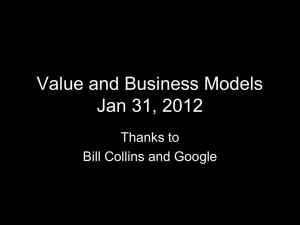Pricing Strategies - PowerPoint Presentation
advertisement

Different Pricing Strategies ©ARC Consulting cc 2012 market skimming contribution pricing value pricing penetration pricing loss leader Pricing Strategies cost-plus pricing psychological pricing predatory pricing competitor pricing ©ARC Consulting cc 2012 Penetration Pricing market skimming contribution pricing value pricing penetration pricing loss leader Pricing Strategies cost-plus pricing psychological pricing predatory pricing competitor pricing ©ARC Consulting cc 2012 Penetration Pricing • Prices set to ‘penetrate the market’ • ‘Low’ price to secure high volumes • Typical in mass market products – chocolate bars, food stuffs, household goods, etc. • Suitable for products with long anticipated life cycles • May be useful if launching into a new market ©ARC Consulting cc 2012 Market Skimming market skimming contribution pricing value pricing penetration pricing loss leader Pricing Strategies cost-plus pricing psychological pricing predatory pricing competitor pricing ©ARC Consulting cc 2012 Market Skimming • High price, Low volumes • Skim the profit from the market • Suitable for products that have short life cycles or which will face competition at some point in the future (e.g. after a patent runs out) • Examples include: Playstation, jewellery, digital technology, new DVDs, innovations and First to Market products etc. ©ARC Consulting cc 2012 Value Pricing market skimming value pricing – contribution pricing penetration pricing based on perceived value loss leader Pricing Strategies cost-plus pricing psychological pricing predatory pricing competitor pricing ©ARC Consulting cc 2012 Value Pricing • Price set in accordance with customer perceptions about the value of the product/service • Examples include status products/exclusive products /art pieces Companies may be able to set prices according to perceived value. Copyright: iStock.com ©ARC Consulting cc 2012 Loss Leader market skimming contribution pricing penetration pricing value pricing Pricing Strategies cost-plus pricing loss leader – sold at cost or below to attract buyers psychological pricing predatory pricing competitor pricing ©ARC Consulting cc 2012 Loss Leader • Goods/services deliberately sold below cost to encourage sales elsewhere • Typical in supermarkets, e.g. at Christmas, selling bottles of gin at R30 in the hope that people will be attracted to the store and buy other things • Purchases of other items more than covers ‘loss’ on item sold • e.g. ‘Free’ mobile phone when taking on contract package ©ARC Consulting cc 2012 Psychological Pricing market skimming contribution pricing penetration pricing value pricing loss leader Pricing Strategies psychological pricing eg R19.99 cost-plus pricing predatory pricing competitor pricing ©ARC Consulting cc 2012 Psychological Pricing • Used to play on consumer perceptions • Classic example - R9.99 instead of R10.99! • Links with value pricing – high value goods priced according to what consumers THINK should be the price ©ARC Consulting cc 2012 Competitor Pricing(Going Rate) market skimming contribution pricing penetration pricing value pricing loss leader Pricing Strategies cost-plus pricing psychological pricing predatory pricing competitor pricing ©ARC Consulting cc 2012 Competitor Pricing (Going Rate) • In case of a price leader, rivals have difficulty in competing on price – too high and they lose market share, too low and the price leader would match price and force smaller rival out of market • In this strategy, we are compelled to follow pricing leads of rivals especially where those rivals have a clear dominance of market share • Where competition is limited, ‘going rate’ pricing may be applicable – banks, petrol, supermarkets, electrical goods – find very similar prices in all outlets ©ARC Consulting cc 2012 Predatory Pricing market skimming contribution pricing penetration pricing value pricing loss leader Pricing Strategies cost-plus pricing psychological pricing predatory pricing competitor pricing ©ARC Consulting cc 2012 Destroyer/Predatory Pricing • Deliberate price cutting or offer of ‘free gifts/products’ to force rivals (normally smaller and weaker) out of business or prevent new entrants • Flooding the market with cheap (often imported) goods • Anti-competitive and illegal if it can be proved ©ARC Consulting cc 2012 Contribution Pricing market skimming contribution pricing penetration pricing value pricing loss leader Pricing Strategies cost-plus pricing psychological pricing predatory pricing competitor pricing ©ARC Consulting cc 2012 Contribution Pricing • Contribution = Selling Price – Variable (direct costs) • Prices set to ensure coverage of variable costs and a ‘contribution’ to the fixed costs/overheads • Similar in principle to cost-plus pricing • Every product sold gives back a contribution towards covering the running costs of the business • Break-even analysis might be useful in such circumstances ©ARC Consulting cc 2012 Cost-Plus Pricing market skimming contribution pricing penetration pricing value pricing loss leader Pricing Strategies cost-plus pricing psychological pricing predatory pricing competitor pricing ©ARC Consulting cc 2012 Cost-Plus Pricing • The cost of the product + mark-up = selling price. • You can do this by using a fixed percentage (150%, 200%) or a fixed markup (R10, R50, R500) • The advantage of this method is that you are able to calculate your expected profit level very easily. • The disadvantage is that it may be less, or more, than customers are willing to pay and, most importantly, some hidden costs may be forgotten and so the actual profit is less than you think (or even a loss) ©ARC Consulting cc 2012 Influence of Elasticity Price Elasticity: • Price elasticity of demand (PED) is defined as the measure of responsiveness in the quantity demanded for a commodity as a result of change in price of the same commodity. • e.g. A 4% rise in price would lead to sales falling by something more than 4% – Revenue would fall • e.g. A 9% fall in price would lead to a rise in sales of something more than 9% – Revenue would rise ©ARC Consulting cc 2012








